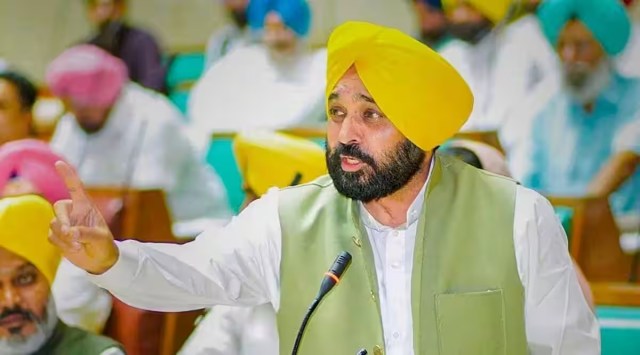Dissolution of Panchayats: Punjab suspends 2 IAS officers after taking ‘U-turn’ in HC
The Punjab government, through its August 10 notification, had dissolved all gram panchayats, panchayat samitis and zila parishads.
 Rural Development and Panchayats Minister Laljit Bhullar said Chief Minister Bhagwant Mann “took swift action”. (File)
Rural Development and Panchayats Minister Laljit Bhullar said Chief Minister Bhagwant Mann “took swift action”. (File) The Punjab government Thursday suspended two senior IAS officers of the Rural Development and Panchayat department for “taking a technically flawed decision regarding the dissolution of panchayats”, hours after it informed the High Court that it will withdraw within two days the August 10 notification.
The orders suspending 1994-batch IAS officer Dhirendra Kumar Tiwari and Gurpreet Singh Khaira (2009 batch), the principal secretary and the director, respectively in the Rural Development and Panchayat department were issued by Chief Secretary Anurag Verma under provisions of Rule 3 (1) of the All India Services (Disciplined Appeal) Rules, 1969.
Rural Development and Panchayats Minister Laljit Bhullar said Chief Minister Bhagwant Mann “took swift action” against Khaira (2009 batch IAS officer) and Tiwari (1994 batch) “when he learnt about the dissolution of the panchayats”.
Bhullar, however, didn’t say why it took three weeks to act against the two officers and why the suspension order was issued only after the government took a U-turn in the high court — a move being seen as a major embarrassment for the Aam Aadmi Party regime.
“There is a very long and cumbersome process for holding the panchayat elections. You have to make corrections in the voter lists, wards and ensure 59 per cent reservation for women etc. That is why we announced the (panchayat) elections early, but due to the floods, the operation was halted as the officers and employees were engaged in relief efforts. We have informed the the high court that the notification will be withdrawn. Now the technical flaws in this process will be rectified and a new notification will be issued,” said Bhullar.
Earlier in the day, Advocate General Vinod Ghai submitted before a division bench of Chief Justice Ravi Shanker Jha and Justice Vikas Bahl that the August 10 notification will be withdrawn within two days. However, the elections would be held according to schedule, said Vikas Mohan Gupta, additional advocate general, Punjab.
The state’s submission came when the bench took up for hearing a clutch of 11 writ petitions, filed by various representatives of the panchayat, questioning the government to dissolve the duly elected bodies before the completion of their term. Those who filed the petitions included Shiromani Akali Dal general secretary Gurjeet Singh Talwandi and Sarabjeet Singh, sarpanch of Mohammadpur village in Ludhiana.
Among other things, Talwandi contended that the panchayats were “illegally dissolved” by exercising power under Section 29A of the Punjab Panchayati Raj Act, 1994. The A kali leader had sought directions for quashing of the communication dated August 11 issued by Controller, Panchayati Raj (finance), Rural Development and Panchayat Department, whereby all financial transactions with the gram panchayat had been suspended.
Talwandi claimed this was illegal, against the public interest, and arbitrary, besides being contrary to Article 21 and Article 243-E of the Constitution and Section 29A of the Punjab Panchayati Raj Act. It was also against the law laid down by the high court in the case of Punjab Panchayati Union and others versus the State of Punjab.
In his plea, Sarabjeet Singh asked whether the state government can dissolve the panchayats under Section 29A of Punjab Panchayati Raj Act before completion of the five-year-tenure “as a matter of right” without giving reason based on public interest?
Section 29A provides for dissolution of Gram Panchayats in ‘exceptional circumstances’ which allows the dissolution “Where election has been announced and the State Government considers it necessary in public interest to do so.”
The Punjab government, through its August 10 notification, had dissolved all gram panchayats, panchayat samitis and zila parishads. According to the notification, the elections of the members of panchayat samitis and zila parishads were to be held by November 25 and those of gram panchayats by December 31.
“..in exercise of the powers conferred by section 29-A of the Punjab Panchayati Raj Act 1994 (Punjab Act 9 of 1994) and all other powers enabling him in this behalf, the Governor of Punjab is pleased to dissolve all the Gram Panchayats with immediate effect; and authorise the Director Rural Development and Panchayats-cum-Special Secretary to appoint persons (Administrators) from amongst the Junior Engineers, Social Education and Panchayat Officers, Village Development Officer and Panchayat Officers, subject to their availability in the respective Block, as the case may be, during the dissolution period of each such Gram Panchayat e.i( till the new elected body assumes charges of office) to perform all the functions and exercise powers of the Gram Panchayats,” read the notofication.
On August 11, the government issued a communication to suspend all the financial transactions with gram panchayats.
In the court, the Rural Development and Panchayats Department submitted that the August 10 notification was issued strictly in accordance with constitutional provisions.
Talwandi’s counsel Baltej Singh Sidhu told reporters that the AG submitted before the high court that the state government is withdrawing the notification dissolving the gram panchayats.
Taking note, the bench said that the submission has rendered the petitions infructuous.
There are 13,241 gram panchayats, 152 block samitis and 22 zila parishads in Punjab. Their term began from date of their first meeting on January 10, 2019. The tenure was to end in January next year before govt notification cut it short by six months.
The state government had submitted in the court that it had the constitutional duty and power to hold the elections of Panchayati Raj Institutions under Section 209 of the Punjab Panchayati Raj Act, 1994. It had also said that an election to constitute a panchayat was to be held before the expiry of its duration or before the expiry of a period of six months from the date of its dissolution. It had also submitted that the August 10 notification was in accordance with Constitutional provisions.







